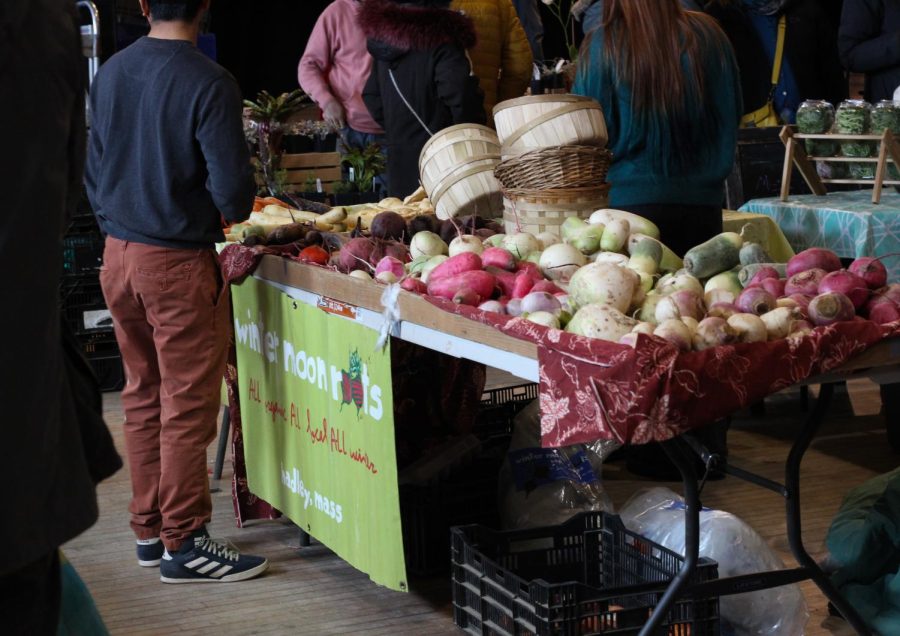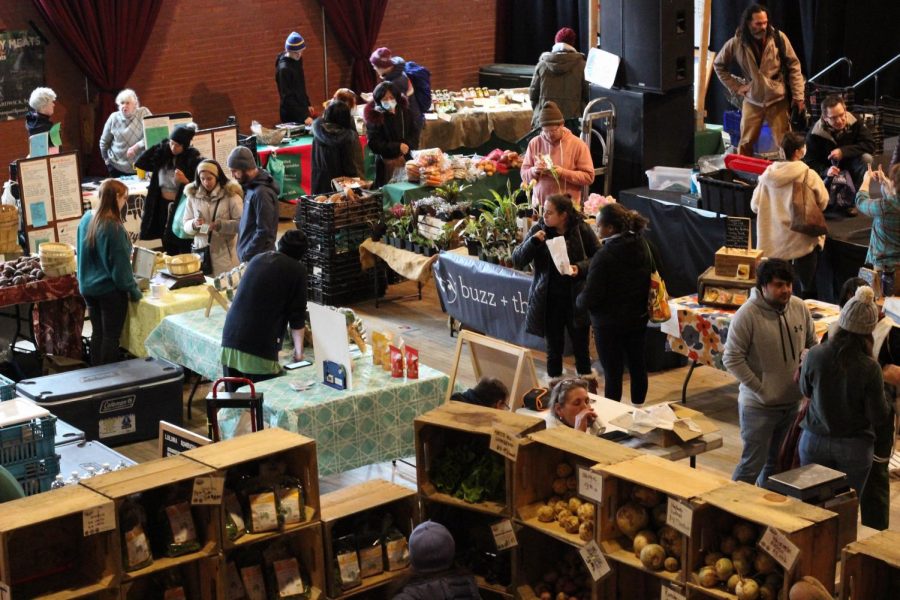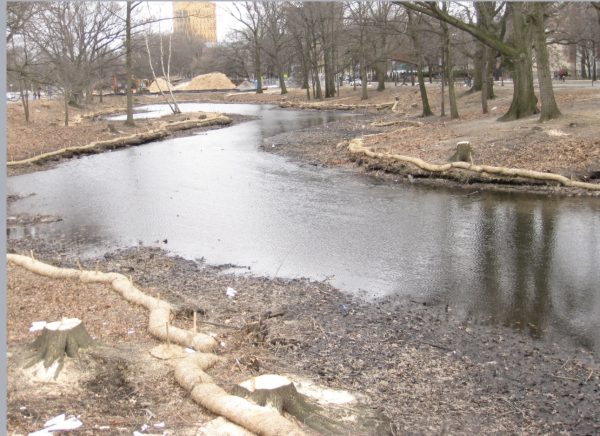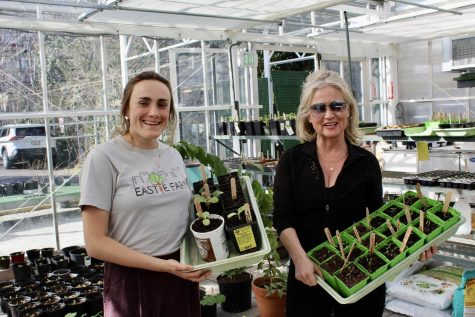Boston-area farmers find solutions for unusually warm winter
Faced with an erratic and unusually warm winter season, these local farmers have had to adapt their practices to keep operations running smoothly this year.
Photo: Elisabeth Hadjis
Boston, MA: Feb. 24, 2023 — In February, many of the stalls at the Somerville Winter Farmers Market look like this one: packed with locally-sourced seasonal root vegetables like carrots, parsnip, daikon and radishes. As climate change influences agriculture practices in the area, farmers may see a shift in their harvest and the produce it yields.
On a sunny February weekend in Somerville’s historic Armory building, the Winter Farmers Market is in full swing. Every Saturday from November to April, the community gathers here to stock up on food and local goods, from coffee beans and desserts to meat and vegetables.
Reusable bags in hand, customers entering the market are greeted by rows of farm stands, their crates teeming with rainbow-colored root vegetables — bushels of purple beets, vibrant pink radishes and crisp, white daikon. Patrons zigzag through the stalls, adding produce to their baskets before paying with cash, card or food stamps, while in the next room over, live music plays from a cafe where tired shoppers rest with their fresh hauls.
For Freedom Food Farm, a regenerative and organic agriculture project based in Raynham, this is a typical Saturday. Although selling their goods to customers here is a simple weekly routine, growing the produce has been anything but easy. Faced with an erratic and unusually warm winter season, these local farmers have had to adapt their practices to keep operations running smoothly this year.
“There’s things that you need to prepare for in cold weather and things you need to prepare for in warm weather,” said Nika Ficano, a staff member at the farm and vendor at the market. “And [now] we kind of have to do both of them.”
Ficano added that the unpredictable weather has led to unexpected challenges in the farming process. For example, bolting — the premature flowering of crops, which makes them unfit for harvest — is a new concern, something they said they typically “wouldn’t be worried about” but have now had to plan for.
Across the Northeast, data echoes this farmer’s observations: This winter has been an irregular one. Temperatures in the region have been far above normal — between 33% and 40% higher, according to data from National Oceanic and Atmospheric Administration. New England has felt the impact acutely. Massachusetts just registered its warmest January in history, while in Boston, the month ended with the fifth-highest average temperatures on record, with a monthly average of 37.8 degrees Fahrenheit.
Chris Skinner is a climate scientist at the University of Massachusetts, Lowell, where he studies the impacts of climate change and extreme weather events. He said that this year’s warm winter is not a fluke, but rather an indicator of changing climate patterns.
“It’s been anomalously warm for sure,” said Skinner. “[You can] look for how many of these really warm winters have occurred in the recent past, compared to going way back. In both cases, there’s a pretty clear signal that climate change is having an effect.”
In this part of the world, rising temperatures aren’t the only indicators of this change. This winter has also featured sporadically chilly weather, like a cold snap in early February which brought Arctic temperatures and strong winds to New England from eastern Canada. At Stillman’s Farm in New Braintree, this cold snap caused the propane tanks powering the farm’s winter greenhouses to explode, resulting in a significant financial loss.
“We harvest everything in the fall, but we are still growing greens in our greenhouse,” said Lainey Chippero, who manages Stillman’s Farm’s retail location at the Boston Public Market. “We lost thousands and thousands of dollars of hydroponic lettuce, and it’s just awful to keep up with.”
For other farmers in the Boston area, the fluctuating weather has made regular, routine processes much more challenging.
Ryan Burke, the harvest manager of Siena Farms in Sudbury, said that the impact of these changes in climate patterns falls largely on spring and summer growing seasons. From late winter through early spring, the farm’s staff thinks about what their growing season might look like. This annual task, in Burke’s experience, has become more difficult due to increasingly unpredictable weather and temperature patterns.
“We do our crop planning, where we plan out all of our seeds that we’re going to grow and transplant throughout the year until November, [and] we have certain assumptions and certain variables that we have control over,” he said. “We can cultivate and spray as needed and do all these things to ensure that we’ll have the best kind of a yield as we can, but a lot of crops will, depending on the weather, just not perform well as we get a certain kind of season.”
To account for the uncertainty, Siena Farms leans on the diversity of their crops. Planting produce with varying resilience to weather events is a technique that can help improve yields in the current climate, helping alleviate some of the financial burden that an unsuccessful crop can put on farmers. For Burke, this is something that larger agriculturalists can afford to do.
“[Climate change] would definitely pose a lot of challenges as a new farm,” he said. “More established farms, they have a little bit of wiggle room in terms of mitigation efforts throughout the season, and they can be a little more forgiving when something kind of craps out on you unexpectedly.”
Produce farmers aren’t the only ones learning to change their ways. Laurie Herboldsheimer is the owner and founder of Golden Rule Honey, a Leominster-based apiary with beehives across Central Massachusetts. In an email, Herboldsheimer said that she’s still not sure how the winter warmth will impact her beekeeping business.
“There are so many variables in beekeeping,” she said. “I have no idea how this winter’s temperatures will affect those variables this year.”
Warmer winters tend to bring less snow and more rain. For Herboldsheimer, these fluctuations in precipitation levels year after year are concerning for her honey production.
“We do need rain for plants to flower, [but] too much rain during blooming can wash out the nectar which impacts honey production,” she said in her email. “Last summer was very dry, followed by rains during the goldenrod [flower] bloom late summer to fall. Both of those things had an impact on the bees’ ability to put food away for the fall.”
Winter isn’t a major growing season for farmers in the region, but with warmer and shorter winters, Burke believes the agriculture industry in the region may begin to rethink their schedules in addition to the things they choose to grow.
“In New England, you’re always looking to extend your season as long as possible,” Burke said. “That’s something I could definitely see happening in the coming years.”
Adapting in this way, Burke said, would require a dramatic shift in farmers’ practices, as well as some degree of forecasting to inform farmers of which patterns might occur, allowing them to get a head start. Although the exact details of future weather events are unpredictable, Skinner said it is possible to gauge the severity and duration of climate trends using historical weather data. With this, researchers can identify what trends to expect in the coming seasons and how long they will go on for.
“Winters in Massachusetts are about four and half [degrees] warmer than they were around the turn of the century, from the 1800s to 1900, and then since the year 2000, out of all the 22 winters we’ve completed since then, only five of them have been colder than average,” said Skinner. “Not only is the trend going up, but some of the warmest winters we’ve had have all occurred in the past 20 years, so there’s a very clear human-driven climate change signal in the warmth that we’re seeing.”
In the coming years, farmers will likely have to continue adapting. Climate experts like Skinner expect that the warm weather is here to stay.
“In terms of making projections for the long term about whether or not we’ll see more winters like this, the answer is definitely yes,” Skinner said. “You’ll have this variability up and down, superimposed on this warming trend. It’s guaranteed that we’ll see more winters like this in the future.”
A warming winter, Skinner warned, doesn’t necessarily preclude a warmer summer, too. But it does seem to have an effect on the duration of the seasons.
“Winter is becoming shorter,” Skinner said. “Fall is getting longer on its end, and spring is starting earlier on. On the other hand, summer is getting longer itself as well, so it’s really just the winter season that’s becoming substantially shorter.”
For local farmers like Burke, the climate change issue is, at its root, a challenge to overcome with resilience — something very familiar to those in the agriculture space.
“One of the most important parts of farming is being able to shift your expectations at a moment’s notice and just work with what you have,” said Burke. “I definitely have faith that farmers will rise to the challenge of some of these things.”
Back at the Somerville Winter Farmers Market, customers continue to shop, happily sifting through russet potatoes and carrots for the perfect batch, blissfully unaware of what it took to get these vegetables into their baskets this year. But, although they may sell different produce or farm in different towns, these vendors have something in common: By trade, they’re tough. And although climate change is challenging generations of agricultural practices, farmers are armed with new techniques and a resilient mindset — and they are ready to meet the moment.












